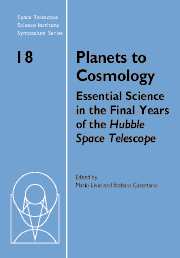 Planets to Cosmology
Planets to Cosmology Book contents
- Frontmatter
- Contents
- Participants
- Preface
- Hubble's view of transiting planets
- Unsolved problems in star formation
- Star formation in clusters
- HST abundance studies of low metallicity stars
- Physical conditions and feedback: HST studies of intense star-forming environments
- Quasar hosts: Growing up with monstrous middles
- Reverberation mapping of active galactic nuclei
- Feedback at high redshift
- The baryon content of the local intergalactic medium
- Hot baryons in supercluster filaments
- Galaxy assembly
- Probing the reionization history of the Universe
- Studying distant infrared-luminous galaxies with Spitzer and Hubble
- Galaxies at z ≈ 6–i′-drop selection and the GLARE Project
- The Hubble Ultra Deep Field with NICMOS
Unsolved problems in star formation
Published online by Cambridge University Press: 17 August 2009
- Frontmatter
- Contents
- Participants
- Preface
- Hubble's view of transiting planets
- Unsolved problems in star formation
- Star formation in clusters
- HST abundance studies of low metallicity stars
- Physical conditions and feedback: HST studies of intense star-forming environments
- Quasar hosts: Growing up with monstrous middles
- Reverberation mapping of active galactic nuclei
- Feedback at high redshift
- The baryon content of the local intergalactic medium
- Hot baryons in supercluster filaments
- Galaxy assembly
- Probing the reionization history of the Universe
- Studying distant infrared-luminous galaxies with Spitzer and Hubble
- Galaxies at z ≈ 6–i′-drop selection and the GLARE Project
- The Hubble Ultra Deep Field with NICMOS
Summary
The study of star formation is currently benefiting from a wealth of new observational data, exploiting the high-sensitivity, wide-field, high-resolution capabilities of a diverse range of space and ground-based instrumentation. In parallel with this, high performance computing is enabling theorists to tackle key problems which—due to their complex geometry and non-linear nature—had long been recognized to be beyond the reach of analytical theory. In this review, rather than reporting progress in each of these areas, I will instead set out some scientific questions that one would expect to be answered before one would regard star formation as a topic that was largely solved. I have accordingly selected three areas: 1) molecular clouds and their relationship to the stars they form and to the wider galactic disk, 2) the question of the determinants of stellar mass (i.e., the IMF), and 3) the issue of protostellar disk dispersal and its relation to planet formation). For each topic, I outline areas of consensus, recent results, and discuss the key problems that can plausibly be addressed in the next five years.
Introduction
In this contribution I have selected three main issues in contemporary star-formation studies. I have chosen these themes because 1) they represent important areas of uncertainty in our current understanding, 2) they involve a synergy between theory and observation, and 3) they span the range of length scales—from planetary to galactic scales—that are involved in different aspects of the star-formation process.
- Type
- Chapter
- Information
- Planets to CosmologyEssential Science in the Final Years of the Hubble Space Telescope: Proceedings of the Space Telescope Science Institute Symposium, Held in Baltimore, Maryland May 3–6, 2004, pp. 13 - 34Publisher: Cambridge University PressPrint publication year: 2006


